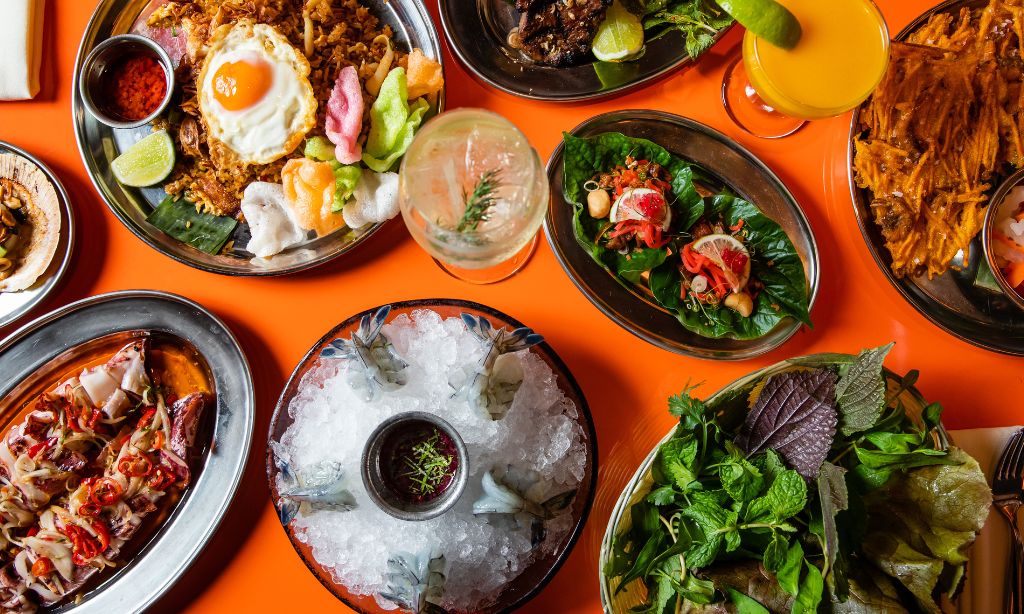I dine out in groups regularly for work and I’ve consistently noticed one thing. It’s more and more common for a group to have dietary requirements (including my own which is vegetarian and no fish or gelatine).
In 2018, research found that 2.5 million Australians (12.1% of the population) reported eating all or an almost-entirely vegetarian diet. In 2013, separate research found that 4.1 million Australians (19.6%) have at least one allergic disease. That number puts Australia at one of the highest rates of documented food allergy and anaphylaxis admissions in the developed world.
Two Australian chefs I talked to confirmed they have seen more dietaries at their restaurants in recent years — and they’re having to be more creative in catering to them.
Why Are Australian Dietaries Rising?
“When I first started cooking over 20 years ago there were barely any dietaries,” says Dan Hong, exec chef of MuMu. “I would say around 2005 onwards, it gradually crept up. But it started with mostly dietaries that were straight allergies or preferences like vegetarian or pescatarian. Now we get all types of intolerances like gluten and dairy as well.”
Alessandro Pavoni, chef at a’Mare, thinks the rise in Australian dietaries stems from an increased awareness of health conditions, the prevalence of chronic diseases, cultural shifts and access to global information. People are being more proactive about their health leading to diets like gluten-free, vegan and low-sodium, he says.
How Are Chefs Catering to These Dietaries?
“Catering to diverse dietary needs has been both challenging and rewarding,” Pavoni says. “It pushes our creativity and deepens my understanding of ingredients.”
Hong feels similarly, saying he once found catering to dietaries frustrating but now likes the challenge. Plus, he says, dietaries are so common these days — chefs are used to them. When the team thinks of dishes to add to the menu, they also ensure they can easily remove certain ingredients like nuts, gluten or sesame to accommodate dietaries.
“It does get hard as a lot of our dishes contain ingredients like shrimp paste and fish sauce even though it may read like a vegetarian or seafood-free dish,” Hong says. “We have managed to buy certain condiments like vegan fish sauce and gluten-free soy sauce.”
That commitment to authenticity is also prevalent in Pavoni’s cooking. He aims to accommodate guests’ dietaries without losing the essence of Italian cuisine. If requests compromise the authenticity of the cuisine or significantly alter the dish’s core identity, he won’t make it.
“While I’m committed to accommodating dietary needs, I believe in maintaining the integrity of the flavours and traditions that define my restaurant,” Pavoni says. “Balance is key, ensuring respect for the cuisine and guest satisfaction.”
Hong also says removing specific ingredients from some dishes would make them taste too different from the original in terms of flavour and overall balance. That’s where he draws the line.
Neither chef mentioned the impact rising dietaries have on restaurants’ profitability but no doubt it’s at least something of a consideration. Alternate ingredients can be more expensive. Sourcing those ingredients, developing a menu with easily tailored dishes and creating those altered dishes can take more time.
Why Are Chefs Making Such Effort?
So why are chefs taking such pains to accommodate dietaries? After all, a restaurant Australian chef Lennox Hastie said was one of his favourites in San Sebastian, Asador Etxebarri, states on its website: “We do not have vegetarian and/or vegan menu.”
As a vegetarian, I’m disappointed I don’t get to try this restaurant Hastie raved about but I understand they don’t want the hassle. That’s their choice, just as it’s my choice to be vegetarian.
There’s no mention of the restaurant catering to other dietaries like gluten- or dairy-free. If I had a diet that was less of a lifestyle choice and more of a necessity for health reasons, I might feel differently. I might also feel differently about my exclusion if my dietary was for religious reasons.
Increasing dietary restrictions are forcing chefs to adapt their menus and practices. Though sourcing ingredients, menu development and maintaining culinary authenticity can be challenging, it also offers opportunities for innovation and creativity. Plus, there’s the joy some chefs get from sharing their food with everyone.
“While [catering to dietaries] requires careful planning and adaptation, the satisfaction of meeting guests’ needs and seeing them enjoy authentic Italian flavours, regardless of restrictions, makes it all worthwhile,” says Pavoni.
Related: Tastemakers: Toby Wilson on Sydney’s Best Tacos — Other Than Ricos’
Related: The Flavourful Mexican Dish Taking Australia By Storm
Read more stories from The Latch and subscribe to our email newsletter.

